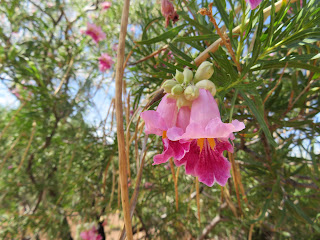The Desert Botanical in Phoenix showcases cacti from the nearby Sonoran Desert. It's best to plan an early morning visit during the summer months. By the time I left at 11am, the temperature was flirting with triple digits on its way to 107 by late afternoon. Cactus seems to thrive in this environment.
Saguaro cactus is prolific in this area of Arizona. And Prickly Pear is everywhere. Its fruit is incorporated into jelly, beer, seltzer, candy, syrup, soda, sorbet, honey, coffee, popcorn, tortilla shells and even salad dressing. My choice was the seltzer.
If you are familiar with the great seal of Mexico, it is a prickly pear cactus the Mexican Golden Eagle devouring a rattlesnake, is perched on. Not to be outdone, the great seal of New Mexico has a similar scene, a Mexican Golden Eagle devouring a rattlesnake while perched on prickly pear AND all of them overshadowed by the outstretched wings of an American Bald Eagle. Hmm, some symbolism there.
Getting around the botanical garden was disorienting. I'm sure I missed some as I wandered around trying to make sense of the garden map. However, every turn presented another of the 4482 species in 50,000+ displays. Not all were cacti. There are only about 2000 cacti species.
A lone bloom on this barrel cactus.
A sign at the garden entrance stated that the cactus family is one of the 5 most endangered of plant families.
Europeans first encountered cactus in the 1500s. Specimens were shipped back to Europe for private collections. Cactus originated in the Americans and is not found elsewhere except where it has been naturalized from American Cactus species. By 1753, Carl Linnaeus had named 23 species. Cactus provided Linnaeus and other botanists with a "thorny" issue. No one quite knew how to classify them. Species bounced between genera and are still subject to reclassification.
If something in the desert doesn't sting or bite you, it will prick you. This flower is alluring but those spiky things keep one from messing with the cactus. Cacti holds moisture and protects that vital resource by arming itself with skin piercing thorns known as "spines" in the Cacti world. Technically, thorns are modified branches and spines are modified leaves.
Many cacti are edible but the spines deter consumption. The most edible cactus is the Pineapple. They can be quite tasty and juicy.
Cacti are flowering plants. Every species produces blooms but some can take up to 30 years of maturity to flower.
A hillside just outside the garden.
Saguaros have pleats which expand when water is plentiful, allowing the plant to store water for leaner times. They grow only in the Sonoran Desert of Arizona. A frost can kill it, so its range is limited to this section of Arizona and only below 4000 feet of elevation.
Saguaro produces a very pretty white flower which has adapted to pollination by bats.
They take their Saguaros seriously here. If you have one on your property and want to remove it, a permit and tag is issued so the cactus can be tracked. Laws protect them in other ways. It is illegal shooting them or ramming them with a vehicle.

























No comments:
Post a Comment